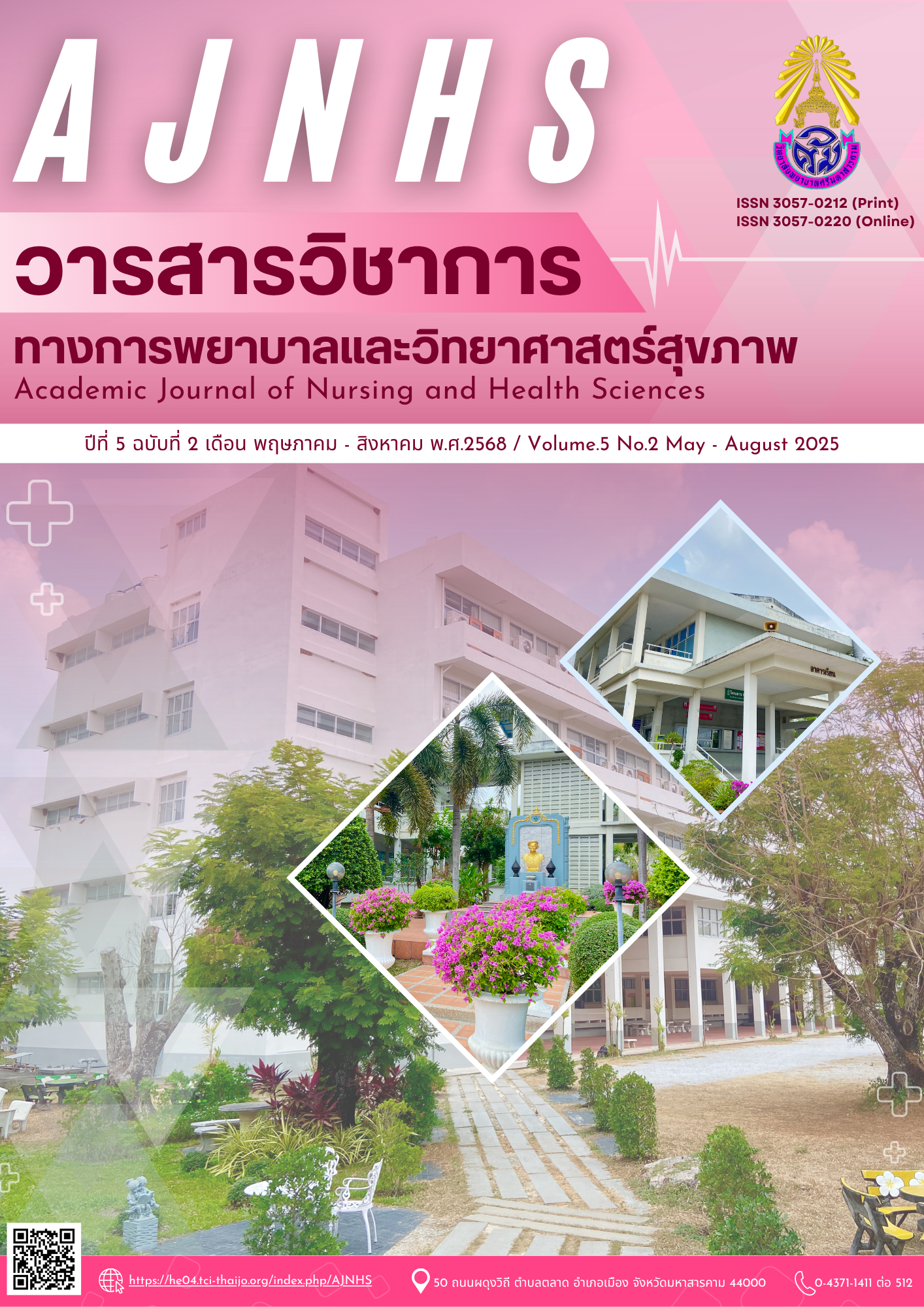การพัฒนาระบบบริการศูนย์ชีวาภิบาลโรงพยาบาลสู่ชุมชนสำหรับการดูแลผู้ป่วยระยะท้าย จังหวัดมหาสารคาม
คำสำคัญ:
ระบบบริการ, ศูนย์ชีวาภิบาล, ผู้ป่วยระยะท้ายบทคัดย่อ
การวิจัยเชิงปฏิบัติการนี้ มีวัตถุประสงค์เพื่อพัฒนาระบบบริการและประเมินผลระบบบริการศูนย์ชีวาภิบาลโรงพยาบาลสู่ชุมชนสำหรับการดูแลผู้ป่วยระยะท้าย จังหวัดมหาสารคาม ดำเนินการพัฒนาระบบริการ ตามแนวทาง Six Building Blocks of A Health System ระยะเวลาวิจัย เดือน ธันวาคม 2566 - มีนาคม 2568 ประเมินผลการพัฒนาระบบจากผลลัพธ์การดูแลผู้ป่วยระยะท้าย รวม 2,186 ราย วิเคราะห์ข้อมูลเชิงปริมาณโดยสถิติเชิงพรรณนา ได้แก่ จำนวน ร้อยละ ข้อมูลเชิงคุณภาพใช้วิธีวิเคราะห์เนื้อหา
ผลการศึกษา พบว่า มีการพัฒนาระบบบริการศูนย์ชีวาภิบาลโรงพยาบาลสู่ชุมชนสำหรับการดูแลผู้ป่วยระยะท้าย จังหวัดมหาสารคาม ประกอบด้วย 1) การจัดระบบสนับสนุนการจัดบริการดูแลรักษาโดยขับเคลื่อนการดำเนินงานผ่านคณะกรรมการระดับจังหวัด ระดับอำเภอ การบริหารจัดการศูนย์ชีวาภิบาลตามมาตรฐาน จัดระบบสนับสนุนทรัพยากรและวัสดุอุปกรณ์ทางการแพทย์ 2) การจัดการระบบการดูแลที่มีประสิทธิภาพ โดยมี Project Manager และ Case Manager เพื่อประสานงาน พัฒนาและเชื่อมโยงทั้งระบบ จัดทำแนวทางการดูแล แนวปฏิบัติทางคลินิก ไลน์กลุ่ม ระบบการให้คำปรึกษา,ระบบส่งต่อ ,ระบบข้อมูลพร้อมทั้งนำสื่อเทคโนโลยีมาสนับสนุนการดูแล 3) พัฒนาทรัพยากรบุคคลตามสมรรถนะแต่ละวิชาชีพทั้งในโรงพยาบาลและพยาบาลวิชาชีพใน โรงพยาบาลส่งเสริมสุขภาพตำบล รวมทั้งพัฒนาอาสาสมัครสาธารณสุขประจำหมู่บ้าน, ผู้ดูแลในครอบครัว ให้มีศักยภาพในการดูแลต่อเนื่องที่บ้าน ผลการประเมิน พบว่า จังหวัดมหาสารคามได้ดำเนินการจัดตั้งและเปิดศูนย์ชีวาภิบาลโรงพยาบาลชุมชนผ่านเกณฑ์มาตรฐานคลุมทุกอำเภอ 12 แห่ง บุคลากรทีมสหวิชาชีพได้รับการพัฒนาสมรรถนะ ร้อยละ 100 มีการประชุมครอบครัวในการดูแลผู้ป่วยระยะท้าย ร้อยละ 96.75 การดูแลตามแผนการดูแลล่วงหน้าในผู้ป่วยระยะท้าย อย่างมีคุณภาพ ร้อยละ 89.20 ผู้ป่วยเสียชีวิตอย่างสงบ ร้อยละ 93.45
สรุปได้ว่า การพัฒนาระบบบริการศูนย์ชีวาภิบาลโรงพยาบาลสู่ชุมชนสำหรับการดูแลผู้ป่วยระยะท้าย ที่พัฒนาขึ้นจากการจากการมีส่วนร่วมและนำ Six Building Blocks of A Health System มาเป็นแนวทางดำเนินงาน สามารถทำให้เกิดการจัดบริการที่มีประสิทธิภาพตอบสนองต่อความจำเป็นในการดูแลผู้ป่วยระยะท้าย รวมถึงการจัดสรรสนับสนุนทรัพยากรได้อย่างเพียงพอ ส่งผลให้ผู้ป่วยได้รับเข้าถึงบริการได้รับการดูแลที่ครอบคลุมทั้งร่างกาย จิตใจ จิตวิญญาณที่เหมาะสมจนถึงวาระท้ายของชีวิต
เอกสารอ้างอิง
กรมควบคุมโรค. (2567). รายงานประจำปี 2566. กรุงเทพฯ: กรมควบคุมโรค กระทรวงสาธารณสุข.
กรมการแพทย์. (2565). Service plan สาขาประคับประคอง (Palliative care). กรุงเทพฯ: กรมการแพทย์
กระทรวงสาธารณสุข.
กระทรวงสาธารณสุข. (2560). แผนยุทธศาสตร์ชาติระยะ 20 ปี (ด้านสาธารณสุข) พ.ศ. 2560–2579. กรุงเทพฯ:
โรงพิมพ์องค์การสงเคราะห์ทหารผ่านศึก.
กระทรวงสาธารณสุข. (2561). รายงานการประชุมผู้บริหารระดับสูง การถอยเพื่อทบทวน (Retreat). กรุงเทพฯ:
กระทรวงสาธารณสุข.
กระทรวงสาธารณสุข. (2567). คู่มือดำเนินการตามนโยบายสถานชีวาภิบาล 2024. นนทบุรี: กลุ่มงานพัฒนาระบบ
บริการ.
กิตติยา วงษ์ขันธ์. (2561). รูปแบบการวิจัยและพัฒนา (R&D) และรูปแบบการวิจัยเชิงปฏิบัติการแบบมีส่วนร่วม
(PAR) [อินเทอร์เน็ต]. สืบค้นเมื่อ 10 กรกฎาคม 2566 จาก http://www.ubu.ac.th/web/files_up/
f2018072012262188.pdf
พรรณี อาจฤทธิ์, และคณะ. (2564). การพัฒนาศักยภาพทีมสหวิชาชีพในการดูแลผู้ป่วยแบบประคับประคอง
ในโรงพยาบาลระดับอำเภอ ภาคตะวันออกเฉียงเหนือ [วิทยานิพนธ์ปริญญามหาบัณฑิต]. มหาวิทยาลัย
ขอนแก่น.
วศิน รัตนพิบูลย์, กาญจนา ธรรมไชย, และศิริวรรณ กาญจนสุต. (2563). การพัฒนารูปแบบการดูแลผู้ป่วย
โรคมะเร็งระยะท้ายแบบในโรงพยาบาลชุมชน. วารสารพยาบาลศาสตร์, 38(3), 24–36.
สำนักงานสถิติแห่งชาติ. (2556). การคาดการณ์ประชากรของประเทศไทย พ.ศ. 2553–2583. กรุงเทพฯ:
สำนักงานสถิติแห่งชาติ.
สำนักงานสถิติแห่งชาติ. (2565). รายงานสถานการณ์ผู้สูงอายุไทย พ.ศ. 2565. กรุงเทพฯ: สำนักงานสถิติแห่งชาติ.
สำนักงานสาธารณสุขจังหวัดมหาสารคาม. (2567). ข้อมูลผู้ป่วย Palliative Care ประจำปี 2566–2567.
มหาสารคาม: สำนักงานสาธารณสุขจังหวัดมหาสารคาม.
สำนักงานสาธารณสุขจังหวัดมหาสารคาม. (2567). รายงานสถานการณ์สุขภาพจังหวัดมหาสารคาม ประจำปี
มหาสารคาม: สำนักงานสาธารณสุขจังหวัดมหาสารคาม.
Murray, E., Ferguson, J., Vincent, C., Walshe, K., & Braithwaite, J. (2020). The role of care
coordination in the governance of health systems: Improving continuity and bridging
service gaps. Health Policy, 124(9), 1021–1028.
Radbruch, L., De Lima, L., Knaul, F., Wenk, R., Ali, Z., Bhatnaghar, S., et al. (2020). Reducing
serious health-related suffering: A key to achieving the Sustainable Development Goals.
Journal of Pain and Symptom Management, 59(2), e2–e6.
Sleeman, K. E., de Brito, M., Etkind, S., Nambiar, V., Carrasco, J. M., Murtagh, F. E. M., et al. (2019).
The escalating global burden of serious health-related suffering: Projections to 2060 by
world regions, age groups, and health conditions. The Lancet Global Health, 7(7), e883–
e892.
World Health Organization. (2007). Everybody's business: Strengthening health systems to
improve health outcomes: WHO’s framework for action. Geneva: World Health
Organization.
ดาวน์โหลด
เผยแพร่แล้ว
รูปแบบการอ้างอิง
ฉบับ
ประเภทบทความ
สัญญาอนุญาต

อนุญาตภายใต้เงื่อนไข Creative Commons Attribution-NonCommercial-NoDerivatives 4.0 International License.


